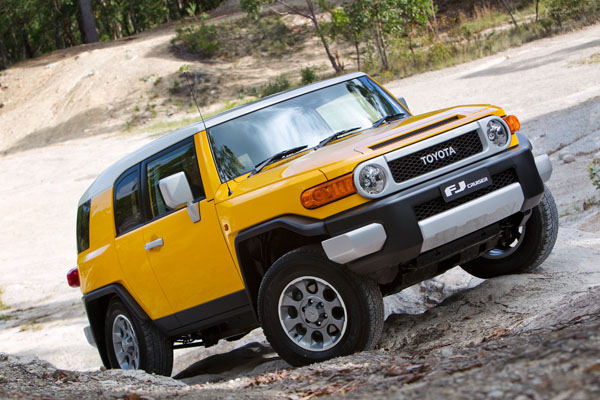 Toyota FJ Cruiser is a tribute to the legendary Toyota FJ 40 LandCruiser. That original Cruiser was a rough ’n’ tough old-style 4WD, whereas the new one that was launched here in March 2011 is much easier to live with. It’s also a lot more capable off-road than most people realise.
Toyota FJ Cruiser is a tribute to the legendary Toyota FJ 40 LandCruiser. That original Cruiser was a rough ’n’ tough old-style 4WD, whereas the new one that was launched here in March 2011 is much easier to live with. It’s also a lot more capable off-road than most people realise.
Our launch took place five years after the FJ Cruiser had been introduced in the USA. Many Aussies had seen it over there, or in photos in local 4WD magazines, and lobbied Toyota to bring it downunder. It didn’t happen overnight, but it did happen.
Toyota FJ Cruiser was aimed at younger buyers, but many baby boomers fell for it as well – and those boomers who grew up in the ‘sex-drugs-and-rock-and-roll’ years brought plenty
Like other retro vehicle, in particular the Fiat 500, Mini and Beetle, the tough Toyota just cries out for customisation. So you may struggle to find a standard model that meets your exact tastes.
Unlike the original Toyota FJ 40 LandCruiser, the FJ Cruiser has four doors. However, the rear doors are tiny and have their handles on the inside. To get to the rear seats you have to open the front door, then squeeze though a rather small slot. All a bit awkward, but Hey! it’s a fun vehicle.
Underneath that fascinating body there’s plenty of Toyota Prado, but on a shorter chassis. This helps keep the price of the FJ way down.
Toyota FJ Cruiser is powered by the 4.0-litre V6 petrol engine as used in Prado and HiLux. It is linked to a five-speed automatic transmission that sends power to all four wheels by way of a dual-range transfer case.
It’s a thirsty beast, particularly off-road due to having to run a petrol engine. A makeover in March 2013 saw an additional tank introduced, more than doubling the capacity and range. At the same time electronics were added to the traction control to further improved off-road ability and on-road safety.
The FJ is fine on the open road, cruising easily at more than 100km/h and has good road feel for its class. That’s because the suspension is tuned for Australian conditions. On fast gravel roads the Toyota points well and corners well with not too much body roll.
FJ Cruiser’s off-road ability is underlined by the clearance necessities: 224 mm of ground clearance under the vital components, the differential housings. There’s a departure angle of 31 degrees, ramp-over of 29 degrees and the all-important approach angle of 36 degrees. As we said, this Toyota is no toy.
Infotainment includes an eight-speaker, six-CD sound system. It has Bluetooth capability and steering wheel controls.
The FJ Cruiser gets the Vehicle Stability Control, active traction control, ABS brakes, Brake Assist and Electronic Brake Force Distribution.
It has six airbags, active head rests for the front seats. Preventing minor crashes are reversing camera and rear parking sensors.
The reversing camera isn’t just for city-slicker parking, we find it very useful in tricky off-road situations where a driver is forced to reverse on steep, narrow tracks.
Toyota has been a major player in Australia for many years and is thoroughly established in the bush as well as the suburbs.
There are dealers all over the place, even in areas where other so-called SUV marques fear to tread. Spare parts may not be in stock in the small, remote areas, but can usually be shipped out within a few business days.
There’s plenty of underbody and underbonnet space so you can do quite a lot of the work yourself.
Insurance charges are generally moderate, though perhaps not quite as low other serious off-road vehicles, probably due to the FJ Cruiser being aimed at those who enjoy peddling along hard.
Like most fad cars sales of the FJ Cruiser tailed off and eventually it was withdrawn from the Australian market midway through 2016.
WHAT TO LOOK FOR
Most FJ Cruisers are only used as pretty on-road machines, others take on the Aussie bush and beaches in the hand of enthusiastic off roaders.
Look for scratches in the doors and sills, as well as bits missing on the bumper corners.
Do an extensive check underneath for signs that the FJ Cruiser and the surface of Australia have come together.
Scars in the luggage area may be another sign the ‘Cruiser has spent a lot of time roaming this great country.
Open the tailgate and see if it sags, even by a small amount – the weight of the spare wheel puts a lot of strain on the door hinges.
Other than that, do the usual checks to see that the engine starts easily, the automatic transmission acts smoothly and accurately and the ABS brakes stop you quickly and in a straight line.
HOW MUCH?
Expect to pay from $14,000 to $21,000 for a 2011 Toyota FJ Cruiser; $16,000 to $23,000 for a 2012 model; $18,000 to $25,000 (2013); $20,000 to $29,000 (2014); $22,000 to $30,000 (2015) and $24,000 to $$33,000 (2016).
CAR BUYING TIP
Put as much time and effort into selecting the best finance and insurance as you do into finding the vehicle.
RECALLS: To browse recalls on all vehicles go to the ACCC at: www.productsafety.gov.au/products/transport/cars/













